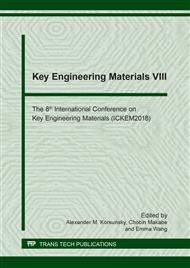[1]
Abduo, M. I., Dahab, A. S., Abuseda, H., AbdulAziz, A. M., & Elhossieny, M. S. (2015). Comparative study of using Water Based mud containing Multiwall Carbon Nanotubes versus Oil-Based mud in HPHT fields. Egyptian Journal of Petroleum.
DOI: 10.1016/j.ejpe.2015.10.008
Google Scholar
[2]
Committee, A. S. S., American Society of Mechanical Engineers. Shale Shaker, C., & Books24x, I. (2005). Drilling Fluids Processing Handbook. GB: Gulf Publishing Company.
Google Scholar
[3]
Fink, J. (2012). Petroleum Engineer's Guide to Oil Field Chemicals and Fluids (First ed.): Gulf Publishing Company.pp.1-115.
Google Scholar
[4]
Ibrahim, L. S. L. a. M. N. M. (2013). Preparation of Lignin Graft Copolymer as a Fluid Loss Additive for Water-based Mud. [Journal]. Journal of Engineering Science,, Vol. 9, 39–49.
Google Scholar
[5]
Akihiro Abe, Karel Dusˇek, Shiro Kobayashi (2010). Biopolymers: Lignin, Proteins, Bioactive Nanocomposites. Springer. p.4.
Google Scholar
[6]
Mihai Brebu and Cornelia Vasile (2010). THERMAL DEGRADATION OF LIGNIN – A REVIEW. Cellulose Chem. Technol., 44 (9), pp.353-363.
Google Scholar
[7]
Yin, L. A. (2008). Isolation And Characterization of Antioxidant Compounds From Pyroligneous Acid Of Rhizophora Apiculata. University Sains Malaysia.
Google Scholar
[8]
Zhu, W. (2013). Equilibrium of Lignin Precipitation. Thesis For The Degree of Licentiate of Engineering.
Google Scholar
[9]
Igor Surina, M. J., Ales Haz, Alexandra Sladkova, Anna Briskarova, Frantisek Kacik, Jozef Sima. (2015). Characterization of Non-Wood Lignin Precipitated with Sulphuric Acid of Various Concentrations. BioResources, Vol 10(1). pp.1408-1423.
Google Scholar
[10]
Tantely Randriamanantena, F. L. R., Georgette Ramanantsizehena, Alain Bernes, Colette Lacabane. (2010). Thermal Behaviour Of Three Woods Of Madagascar By Thermogravimetric Analysis In Inert Atmosphere.
Google Scholar
[11]
Alderman, N. J., Gavignet, A., Guillot, D., & Maitland, G. C. (1988). High-Temperature, High-Pressure Rheology of Water-Based Muds.
DOI: 10.2118/18035-ms
Google Scholar
[12]
Omotioma M., E. P. C. N. a. U. J. I. (2015). Improving the Rheological Properties of Water-Based Mud with Addition of Cassava Starch. Journal of Applied Chemistry, 8(8 Ver 1), pp.70-73.
Google Scholar
[13]
Safi, B., Zarouri, S., Chabane-Chaouache, R., Saidi, M., & Benmounah, A. (2016).
Google Scholar
[14]
Larry Mitchell, J. A. T., Jerry Reimer, Harry Dearing. (2004). Measurement of HTHP Fluid Loss Equipmemt and Test Fluids with Termocouples. American Association of Drilling Engineers, pp.1-14.
Google Scholar
[15]
Zhu, W. and Theliander H. (2015). Precipitation of Lignin from Softwood Black Liquor: An Investigation of the Equilibrium and Molecular Properties of Lignin., BioResources 10(1), 1696-1714.
DOI: 10.15376/biores.10.1.1696-1715
Google Scholar
[16]
Norgren M., and Linstrom B. (2000a). Dissociation of phenolic groups in kraft lignin at elevated temperatures. Holzforschung54(5),519-527.
DOI: 10.1515/hf.2000.088
Google Scholar
[17]
Theliander, H. (2010). The Lignoboost process: Solubility of lignin,, International Chemical Recovery Conference, Williamsburg, VA, pp.33-42.
Google Scholar
[18]
Dereca Watkins, M. N., Mahesh Hosur, Alfred Tcherbi-Narteh, Shaik Jeelani. (2015). Extraction and Characterization of Lignin From Different Biomass Resources. Journal of Materials Research and Technology, Vol 4(1), pp.26-32.
DOI: 10.1016/j.jmrt.2014.10.009
Google Scholar
[19]
Azar, J. J., & Lummus, J. L. (1975). The Effect of Drill Fluid pH on Drill Pipe Corrosion Fatigue Performance. Society of Petroleum Engineers.
DOI: 10.2118/5516-ms
Google Scholar


